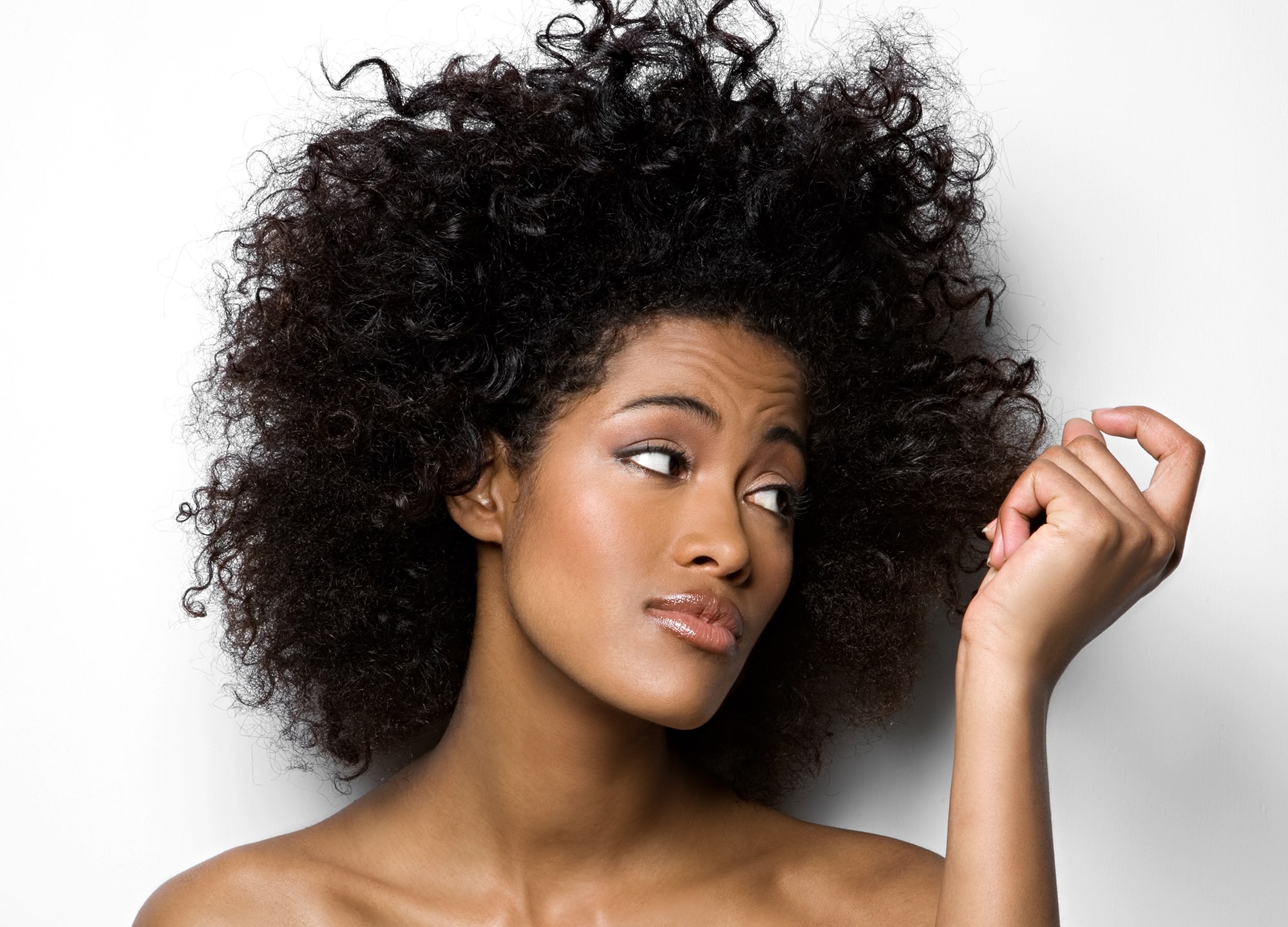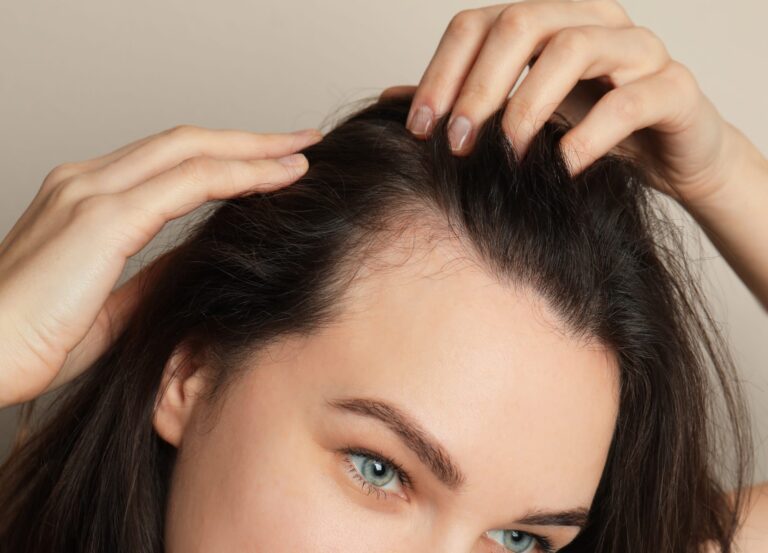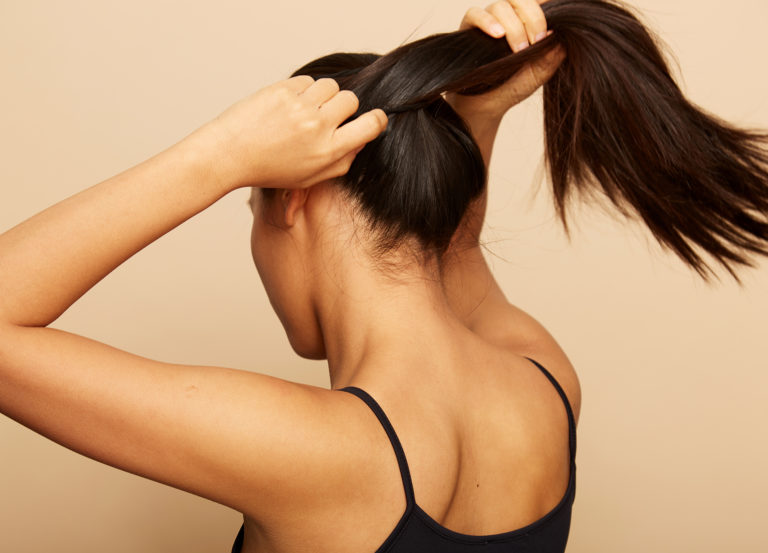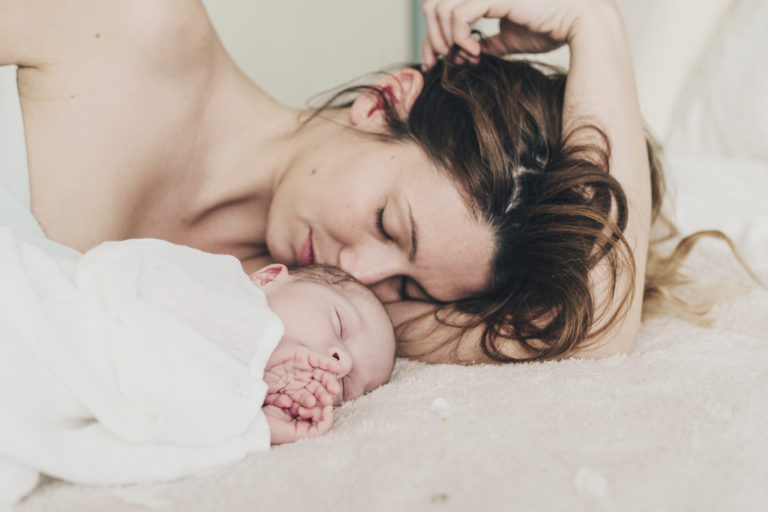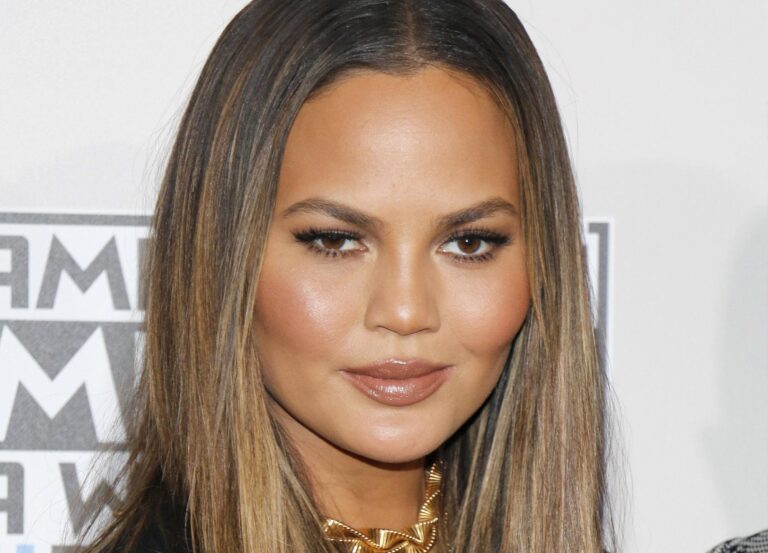Few cosmetic concerns have a more gripping psychological impact than hair loss. If you’ve ever experienced it, then you’re likely familiar with the feelings of fear, anxiety and embarrassment it can ignite. You’re not alone in this: According to the American Hair Loss Association, 40% of women suffer from hair loss. Still, our hair is our crowning glory—and seeing it slip down the drain without explanation can be devastating.
First and foremost, try not to panic: it’s important to distinguish normal everyday shedding from the kind that requires early intervention. You can expect to lose 25 to 100 hairs per day as part of the body’s natural shedding process—you may see them tangled in your brush, strewn across your pillowcase or clinging to your sweater. But if you notice hair falling out at a more rapid clip or in significant clumps, you’ll want to seek professional help—and the sooner the better. “By the time the average person notices their hair is thinning, as much as 50% has been lost,” says Dr. Corey Hartman, a dermatologist in Birmingham, Alabama.
Before starting any treatment, “I do a thorough examination of the scalp and check labs, if needed,” says Dr. Papri Sarkar, a dermatologist in Brookline, Massachusetts. “For most of my patients, the cause of hair loss is hormonal, but other common causes of thinning in women are hair damage from styling/product use, medical problems or medications, and traumatic events, such as the death of a loved one, a major surgery or a car accident.”
While hair restoration techniques for women and men alike are better than ever (and “Worth It,” according to 92% of RealSelf members), prevention will always be preferable. If you suspect your hair might be thinning, don’t delay—seek help from a board-certified dermatologist or hair restoration surgeon so that a firm diagnosis can be made. In the meantime, incorporating these simple, doctor-approved tricks can help you get ahead of hair loss.
Understand alopecia
Alopecia is simply the medical term for hair loss on the scalp or body. There are multiple variations—and not all of them cause permanent hair loss. “I can think of over 20 different types of alopecia without consulting a textbook,” says Dr. Hartman. “Some, like androgenetic alopecia, telogen effluvium and [the autoimmune disease] alopecia areata affect all races of people. Others, like central centrifugal cicatricial alopecia (CCCA), traction alopecia and frontal fibrosing alopecia (FFA) more commonly strike people of African descent.” The most common kind of hair loss is androgenetic alopecia, a hereditary condition also referred to as male- or female-pattern baldness. “In androgenetic alopecia, there is often a superimposed deficiency of some vitamins or minerals, especially iron or B12,” notes Dr. Sarkar.
Don’t ignore dandruff
“Oftentimes dandruff is caused by seborrheic dermatitis, which is thought to be an immune [system] response to yeast in our sebaceous glands,” explains New York City facial plastic surgeon and hair restoration specialist Dr. Gary Linkov. It sparks mild inflammation that makes the scalp red, itchy and scaly. If the inflammation progresses and goes unchecked, it can actually destroy hair follicles. The itching associated with dandruff can trigger scratching, thickening of the affected skin and hair breakage. Depending on the level of severity, a dermatologist or hair specialist can suggest the proper treatment—be it a prescription-strength or over-the-counter antifungal shampoo (containing zinc pyrithione, ketoconazole or selenium sulfide) or a mildly exfoliating formula with salicylic acid or urea. Hair loss resulting from this scalp condition typically reverses once the dermatitis is under control. Keep in mind that anti-dandruff products can be irritating over time and cause inflammation of their own, so Dr. Linkov suggests alternating them with a nonmedicated moisturizing shampoo. Talk to your doctor about your best course of treatment.
Don’t rely on cleansing conditioners alone
Cleansing conditioners and the no-poo method of cleansing favored by thicker, coarser hair types can be great moisture preservers for folks prone to dryness, but they can’t be one’s sole cleansing option—particularly for those layering heavier styling products on top. Dr. Hartman says that although shampoo is desired by some to limit oiliness and avoided by others preserve it, there are dangers that can come from abstaining from traditional shampoo altogether. “It may encourage yeast or fungi to grow, since both thrive in an oil-rich environment. And if dead skin cells and dirt build up on the scalp, they can make hair more prone to shedding and breakage.”
Another reason to suds up: New research shows a link between air pollution and hair loss. After being exposed to two common types of particulate matter (diesel and dust) for a 24-hour stretch, human scalp cells taken from the base of hair follicles showed decreased levels of specific proteins responsible for hair growth and retention. Dr. Linkov points out “the actual effect of air pollutants on follicular cells in real life may not be as drastic, since in our bodies, those cells are protected by scalp skin [and] not as exposed [as the cells in the study].”
While urbanites needn’t panic, he recommends a monthly deep clean with a traditional shampoo, clarifying shampoo or even a scalp rinse, like apple cider vinegar, to cast off unwanted residue while preserving natural oils.
Rethink protective styles
“The term ‘protective style’ has been used broadly and incorrectly to describe many styles that are actually quite destructive,” says Dr. Hartman—particularly tight braids, heavy or taut weaves, and high ponytails. “Tight, tugging hairstyles put traction on the scalp, especially when worn over time,” adds Dr. Amy McMichael, a dermatologist at Wake Forest Baptist Health in Winston-Salem, North Carolina. That tension causes inflammation at the site of hair follicles—the precipitating factor for many different forms of scarring alopecia—eventually causing vulnerable strands (especially fragile edges) to fall out. What’s more, adds Dr. McMichael, “styles that don’t allow for regular washing can increase the risks for itchy scalp, leading to scratching and hair breakage.”
Use scalp exfoliators sparingly
Of the many scalp treatments to invade the hair space of late, gritty pre-shampoo exfoliators aiming to rid the scalp of buildup and boost circulation have gotten a lot of airtime. But Dr. Linkov says there’s little evidence to prove that they’re actually doing anything. “There is no literature to support scalp exfoliants for hair growth,” says Linkov. In fact, if used too often or aggressively, they can actually trigger follicle-damaging inflammation.
Curb your dry shampoo habit
It may seem like oil-absorbing hair powders would cake up follicles over time, stunting hair growth. But Dr. Hartman says it’s actually scalp inflammation resulting from excessive product residue that can cause hair loss—an inflamed scalp simply doesn’t anchor hair follicles well. The inflammation can present as redness, dryness, itching, bumps, stinging or overall tenderness—all of which may spark scratching, further exacerbating inflammation and causing additional breakage at the roots.
The second you notice scalp irritation, shelve your dry shampoo until things balance out.
And if you tend to use it as more than an occasional fix, work a weekly deep clean into your hair-care routine in order to prevent problems. While a gentle clarifying shampoo with added body builders, like Oribe The Cleanse, will suit fine hair, Hartman recommends the LivSo Moisturizing Shampoo for dry, textured strands in need of purifying plus hydration.
Don’t forget to brush
When hair is brushed regularly, it allows the hair in the telogen, or resting, phase to be shed more efficiently. Only 10–15% of total hair is in the telogen phase at any given point. The shedding of telogen hair is a normal phenomenon and an important part of the healthy hair cycle. But Dr. McMichael warns not to overdo it: “Don’t brush the hair too frequently or for long periods of time, because this can increase hair breakage.” Aggressively raking the scalp can also stir up harmful inflammation. Our experts agree that brushing does very little for actual scalp health. While (myth alert!) there is no ideal number of hairbrush strokes, less is generally more—detangle, style and be done.
Consider preventative PRP
Platelet-rich plasma (PRP) is a nonsurgical treatment that harnesses the growth factor–rich stem cells from one’s own blood to stimulate hair growth. Once blood is drawn from your arm, it’s spun down in a centrifuge to separate out the plasma. This so-called “liquid gold” is then injected or microneedled into the scalp to boost blood flow to the hair follicles, resulting in a thickening of existing hairs along with the sprouting of new strands. “Those who are at the beginning of their hair loss journey, with decent scalp coverage, tend to have the best results from PRP,” notes Dr. Sarkar. “That being said, most of my patients come to see me after they’ve had years of hair loss, and even in cases of significant thinning, we’ve been seeing success. I warn them though—it won’t work in everyone, and it’s hard to predict who it will and won’t help.” The less hair you currently have, the more treatments you may need, she adds. Dr. Sarkar typically recommends three or four treatments about a month apart, followed by a course of maintenance injections.
“There have been many small studies on PRP—one found that it’s more effective than topical minoxidil, which has generally been the go-to treatment for women—but large randomized controlled trials are still needed,” explains Dr. Sarkar. “The existing studies are varied in terms of how successful the treatment is for hair loss, but recent trials have shown success.”
In many cases, a doctor’s prescribed hair-regrowth regimen will include PRP in conjunction with a personalized supplement cocktail, among other things. “Vitamin supplementation and prescription oral and/or topical medications are always part of the treatment regimen,” says Dr. Hartman. “The PRP acts to wake up the hair follicles, and the adjunct treatments serve to nurture the hair growth.” Again, such combos perform best at the first sign of thinning.
Related: Kourtney Kardashian Visits Facial Plastic Surgeon for Hair Loss Treatment
Supplement what’s deficient
While beauty pills, like Viviscal and Nutrafol, have acquired legions of fans since their respective launches, some doctors prefer to take a more customized approach to feeding deficiencies. “I find that most patients really need only one, two or no supplements,” says Dr. Sarkar. “And I’d rather they take what they’re deficient in than an expensive catch-all pill that includes nutrients they may not need.”
A simple lab test can determine which nutrients, if any, you’re lacking. When thinning is suspected, Dr. Sarkar typically tests for levels of thyroid-stimulating hormone (TSH, a common cause of correctable hair loss); iron; vitamins B12 and D3; and biotin.
“If there are deficiencies or hormonal abnormalities, these [supplements] can help,” adds Dr. McMichael. But if, for example, you’re not anemic—a condition commonly associated with thinning—taking an iron supplement isn’t going to kick follicles into high gear.
Biotin has long been heralded as a cure-all for hair and nails. But according to Dr. Hartman, biotin may decrease hair breakage by strengthening the hair shaft, but it does not directly prolong hair’s growing phase. Plus most people consume enough biotin through their diet, so the need for supplementation is widely overblown.
Don’t stress about everyday stress
File under Phew!: according to Dr. McMichael, it’s untrue that psychological stress—the unavoidable kind roused by deadlines to meet and kids to feed—directly causes hair loss. Physiologic stress, however, is another matter. “Significant weight loss, having a baby, starting or stopping oral contraceptives, undergoing general anesthesia or surgery—these kinds of bodily stressors actually can spark a type of thinning called telogen effluvium. This is a diffuse shedding from all over the scalp that usually comes three months after the precipitating event and lasts for approximately six months,” Dr. McMichael says. The jarring incident first causes the body to cease it’s natural shedding process temporarily. Later, when it resumes, hair falls out in what seems like significant clumps. Six months or so following the trigger, hair regrows close to what it was prior to the loss.







